Underground Metropolis: The Subterranean World of Maresha
024
024
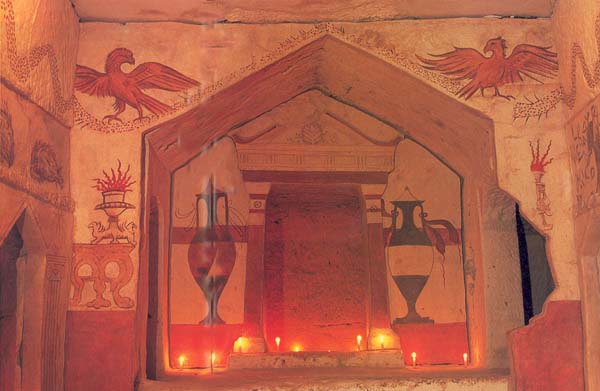
Much of our work at the site of Maresha takes place underground—in tombs and in caves.1 BAR readers will not be surprised by the number of tombs, two of them with their walls covered with spectacular paintings. Much less common, however, are Maresha’s hundreds of caves. The subterranean labyrinth of spacious halls, small chambers, extensive winding corridors and industrial installations has led some to call Maresha an underground city.
Maresha lies in the heart of the Shephelah, the rolling hills of Judah between the coastal plain and the mountains in central Canaan, about a thousand feet above sea level, 27 miles from the Mediterranean, 35 miles south of Jerusalem, less than 4 miles northeast of the major Judahite city of Lachish and just outside the modern kibbutz of Beit Guvrin. The site consists of an upper city (the tell) and, surrounding the tell, a lower city, which includes the underground caves. Most of the 027underground caves and painted tombs date to the Hellenistic period (third to second century B.C.E.).
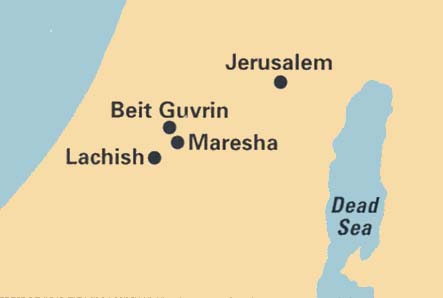
Joshua 15:44 describes Maresha as one of the Canaanite cities allotted to the tribe of Judah. Solomon’s son Rehoboam, the Bible also tells us, fortified Maresha as a defense against potential Egyptian aggression (2 Chronicles 11:5–12).
The identification of the remains of Biblical Maresha provides an interesting lesson in Biblical topography. The Arabic name of the site is Tell Sandahanna (which means either Saint Anna or Saint John [Yehohanan in Hebrew]). Less than a mile south of Tell Sandahanna, however, is the site of Khirbet Mar‘ash (the ruin of Mar‘ash). Because of the similarity of the names, the great mid-19th-century French geographer Victor Guérin identified Khirbet Mar‘ash as Biblical Maresha; so did the London-based Palestine Exploration Fund’s Survey of Western Palestine.
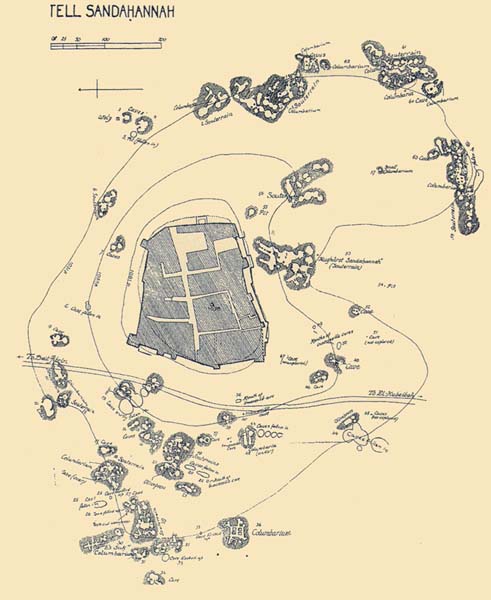
Based on the location of Maresha in the third-century C.E. Onomasticon by the church historian Eusebius, however, the American explorer Edward Robinson opted for Tell Sandahanna as the site of Biblical Maresha. In the late 19th century, the British archaeologist Sir William Flinders Petrie,a sometimes called the father of Palestinian stratigraphical archaeology, examined the surface pottery at Khirbet Mar‘ash. Finding nothing earlier than the Roman period, Petrie concluded the site could not have been Biblical Maresha. The pendulum therefore began to swing to Tell Sandahanna as the site of Maresha.
Finally, in 1902, when the New York archaeologist Rev. John Peters and his German colleague Hermann Thiersch were shown an impressive painted tomb we will look at in some detail later, they found a Greek inscription above the tomb of one Apollophanes, son of Sesmaios, who is identified as “chief of the Sidonians at Marisa” (the Greek form of Maresha). This inscription conclusively pinned down Tell Sandahanna as Biblical Maresha.
The lesson: Modern place names, although often helpful in identifying ancient sites, must always be used cautiously, in conjunction with all the evidence. In this case the name Mar‘ash was misleading. Indeed, our 029excavations have proved beyond doubt that Sandahanna is Biblical and Hellenistic Maresha. Perhaps Khirbet Mar‘ash got its name from some association with nearby Maresha.
The most prominent hill in the vicinity, Maresha’s upper city rises about a hundred feet above its surroundings. Its steep 40-degree slopes cover two lines of defensive walls, the upper one with corner towers.
We extensively excavated the northwestern tower of this wall. Some of the tower walls are more than 10 feet thick, and parts of the walls remain standing to a height of nearly 20 feet. The tower’s two phases both date to the Hellenistic period. Our probes beneath this tower revealed walls from the period of the Judahite monarchy (as early as the eighth century B.C.E.) and from the Persian period (fourth century B.C.E.), when the Persian empire ruled the east.
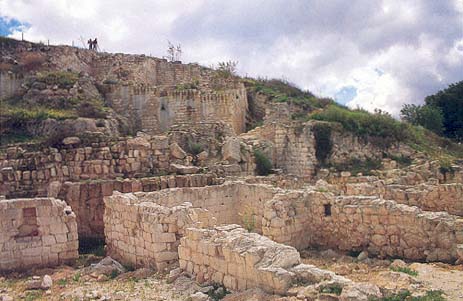
In the Hellenistic period, the city on the tell proved insufficient for the expanding population, and the lower city was created about 50 to 100 feet down the slope, surrounding the upper city. The lower city was far larger than the city on the tell: 80 acres compared to 6 acres. A 4-foot-thick wall with offsets and insets surrounded at least part of the lower city.
Unfortunately, only the lowest parts of the buildings in the lower city have survived. The blocks of stone of which they were constructed were later worn down by the elements and pillaged for use in other buildings. But enough remains to determine the plan: The buildings were arranged in rectangular blocks (called insulae, or islands) enclosed by streets and alleys. Although no second story has survived, we do have the remains of several stairways that led upstairs, as well as material that collapsed from an upper floor. In one house we found four Ionic capitals worked on one side only. Two Ionic corner capitals with only a quarter of their circumference carved were also found. Probably the second-floor hall was decorated with an Ionic facade engaged in the wall. This is confirmed by the discovery of columns also worked only partway around.
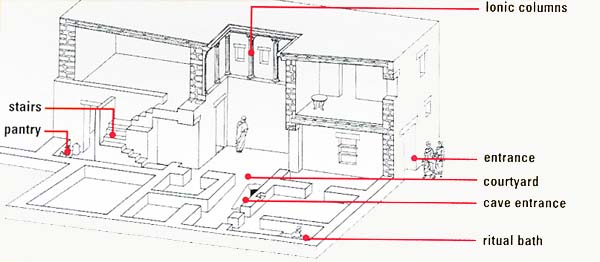
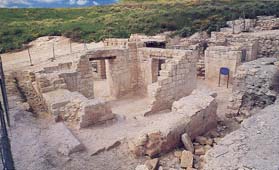
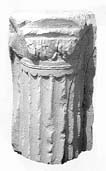
Many of the buildings, including the residences, in this lower city have unusually extensive man-made caves beneath them. Entrances to most of the caves are in courtyards and in corridors between the buildings.
Geologically, the area around Maresha consists of an Eocene limestone formation: Beneath a harder surface crust, known locally as nari, is a soft chalk that can easily be worked. To dig the caves, a hole was first chipped through the nari crust, and then the soft chalk beneath was hewn away, creating a short “chimney” that was gradually widened as it deepened. In all, there are up to 2,000 caves in Maresha and the surrounding area. The shape and character of each cave depended on its function—storage room, olive oil factory, pigeon cote, water cistern or some other purpose.
Frederick Bliss and Robert Alexander Stewart Macalister conducted the earliest excavation of Maresha in 1900 on behalf of the Palestine Exploration Fund.2 Despite the brevity—barely three months—of their project, Macalister, who was in charge of the cave survey, identified 63 subterranean cave complexes, which he called “souterrains.” Certain souterrains contained as many as 30 separate rooms and caves. Even if a cave complex had more than one entrance from the surface, 030Bliss and Macalister classified the complex as a single souterrain if a person could pass from one cave to another through an existing aperture—whether a breach in the chamber walls or a crawl space made at a late date. In 1980 we began to add cave complexes to their list, beginning with the number 70. We have now reached complex 170, with no end in sight.
In one of the cave complexes we excavated (number 75), we found a clear-cut stratification of installations and floors. The earliest stratum dates to the late Iron Age (eighth to seventh century B.C.E.). Other strata are datable to the Persian period (fifth to fourth century B.C.E.). But the most extensive rock cutting clearly occurred in the Hellenistic period (late fourth to second century B.C.E.). Although part of this cave complex apparently was in use in these early periods, the fills of the caves contain only Hellenistic finds, which indicate they were cut and used primarily in this period.
It is not always easy to determine the function of each room in a cave complex, but clearly many of them were used for the production of olive oil. (This is true not only of the Maresha caves but also of other caves we identified during a 1985–1995 survey of the region.) We have found olive oil production plants in 22 of the cave complexes at Maresha. These include crushing and pressing rooms, storage rooms, water cisterns and, in some, ornate cultic niches (see “The Olive Oil Factory”).
Thanks to the stable conditions inside the caves, some of the olive oil presses are extremely well preserved. (The microclimate in the caves is comfortable and steady the year round, although the humidity is relatively high.) The typical plant has a large main chamber in which the press is located. In one of the smaller complexes, for example, this main chamber measures 20 feet by 12 feet and is 10 feet high. Some of the walls have a cornice cut into the rock just below the ceiling. Obviously, whoever made the caves took pride in the work.3
To make olive oil, the olives were first crushed in a stone basin 5 or 6 feet in diameter, called a mortarium in Latin and a
Many of the olive oil workshops have small niches carved into the walls about 3 feet above the floor. The niches are usually about 2 feet high and of varying shapes. Some have rounded tops, others are gabled or mushroom shaped. They probably served a religious function. Offerings were apparently placed in the niches and then some ritual was performed. Some of the niches have a stone-cut ledge in the form of an altar, on which offerings and libation bowls may have been placed and incense burned.
In the olive oil production workshops, the gods may have been invoked to ensure a good crop and abundant oil. But what gods? To answer this question, we must return briefly to the history of the Maresha region. During the late seventh and early sixth centuries B.C.E., when Judah was already weakened and threatened by the Babylonians (who eventually destroyed Jerusalem in 586 B.C.E., thus ending the kingdom of Judah), the Edomites from the southeast made incursions into southern Judah and occupied much of it. This region then came to be known as Idumea (from Edom), and Maresha was its chief town.
032
The demise of the Babylonian empire signaled the beginning of the Persian period, followed by the Hellenistic period. Toward the end of the Persian period, Sidonians from Phoenicia moved to Maresha, and they were soon followed by Greeks, who introduced Hellenistic culture (remember, the inscription above the tomb of Apollophanes identified him as “chief of the Sidonians at Marisa”). This bit of history provides the basis for some speculation as to who was propitiated in the niches in the walls of Maresha’s olive oil factories.
The niches may have been connected with the rites of the Edomite god Qos—or the Greek gods Aphrodite and Apollo. Beneath one of the niches a bronze statuette of Heracles was found, which may point to his cult as well.
In any event, olive oil was clearly an important product of the area, not only for local consumption but for export as well. The Shephelah was extensively planted with olive groves throughout its history. Olive groves must have extended over thousands of acres in the valleys and slopes around Maresha in the Hellenistic period. Situated at an important crossroads, the city also enjoyed a commercial advantage.
Between 6,000 and 10,000 people lived at Maresha in the Hellenistic period, according to the best population estimates, and the city had at least 30 olive oil processing plants. According to our calculations, they produced nearly 300 metric tons of olive oil each year—and this is a cautious assessment. Obviously, Maresha was a major olive oil supplier.
After the death of Alexander the Great in 323 B.C.E., his kingdom was divided between the Seleucids in Syria and the Ptolemies in Egypt. Idumea, like all the southern Levant, fell first under Ptolemaic rule. The Hellenistic city of Maresha, with its multi-ethnic population, was an important commercial center under Egyptian rule in the third century B.C.E. and then under the Syrian Seleucids in the second century B.C.E. Our recent finds have shown that in 112 B.C.E. the Hasmonean king John Hyrcanus I conquered Maresha. The Hasmoneans destroyed the city, and the residents were given the choice of conversion to Judaism or expulsion.
The olive oil industry did not recover from this destruction so quickly, however. Hasmonean Palestine was dominated by the Seleucids, who made it difficult to export oil to Egypt, which was ruled by the Ptolemies. Some of the olive oil factories were abandoned and enlarged into cisterns. Others were used as stone quarries for later building. In the mid-first century B.C.E. Roman rulers replaced the Seleucids. Maresha suffered another destruction in 40 B.C.E., when the Hasmonean ruler Antigonus Mattathias, together with allies from Persia, revolted against Roman rule.
This was not the end of olive oil production in this fertile area, however. During the Byzantine period (fourth 033to seventh century C.E.), olive oil production was apparently renewed with improved oil-pressing equipment.
Apart from olive oil production, the most common function served by the underground caves at Maresha was as pigeon cotes. The birds were apparently raised for ritual purposes, for food and for their dung, which served as fertilizer. More than 85 columbaria (pigeon cotes), with more than 50,000 small pigeon niches, have been found in the underground city. Located in narrow halls, the niches form a checkerboard pattern across the upper walls. The lower third of the walls was left smooth to prevent predators from climbing up.5
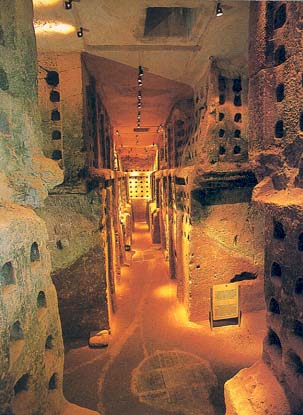
The caves were used for many other purposes, not all of which we can determine. Some were used as stables for animals. Others were used for storage, water cisterns, baths (perhaps ritual baths—the necessary bathtubs and basins have been found) and religious functions.
We now turn from the living underground city to the burial caves of the deceased. Maresha’s burial grounds formed a belt around the lower city, although concentrated in three areas. All the tombs date to the Hellenistic period; we have not yet found burials from the Iron Age or Persian period.6
The most famous of the Hellenistic burial caves was discovered in 1902.The first westerners to enter it were John Peters and Hermann Thiersch, who discovered the inscription identifying the site as Maresha.7 Peters and Thiersch, then on a tour of the 034Holy Land, were trying to track down the source of a rumor. Some Arab villagers had sold items to a Jerusalem antiquities dealer for 50 pounds—quite a considerable sum in those days—and, the story went, the goods had come from an ancient tomb the Arabs had discovered near Beit Jibrin (Guvrin).
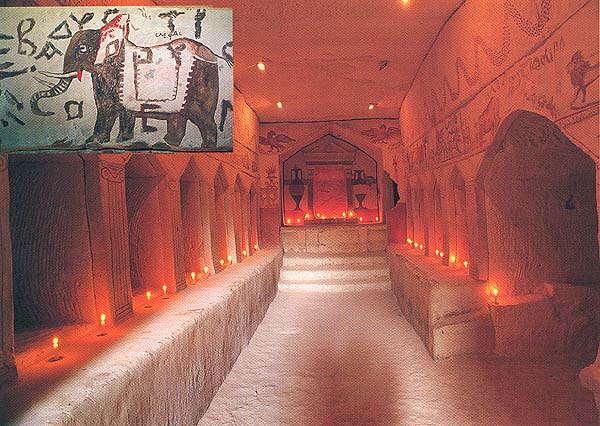
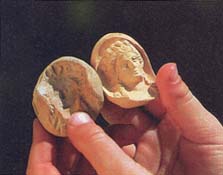
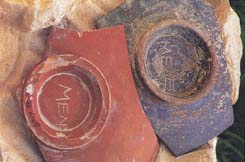
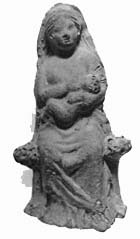
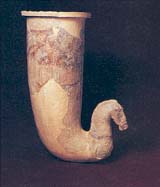
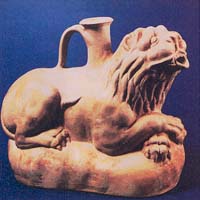
At the time, Tell Sandahanna had recently been excavated by Macalister and Bliss. Peters and Thiersch hired an Arab guide who showed them the site and then asked if they wanted to see something special. They later wrote:
[The guide] led us to an insignificant looking hole in the ground, in the long line of grave excavations on the east side of the Wadi el-Biad, opposite Tell Sandahannah. We had been so often deceived, and induced to descend with exalted expectations into holes that proved to contain nothing of interest, that it was with some hesitation, the hour being then quite late, and only on our guide’s reiterated assurances of the real importance of this hole, that one of us descended into it. It proved to be the most remarkable tomb ever discovered in Palestine.8
This and another tomb to which they were quickly led were decorated with unique wall paintings, which Peters and Thiersch correctly dated to the Hellenistic period. Unfortunately, the faces in the paintings had already been mutilated by the sheikh of Beit Guvrin, who regarded them as sacrilegious under Islamic law.
A week after seeing the paintings, Peters and Thiersch returned with Selah Merrill, the American consul in Jerusalem, and C. Raad, a Jerusalem photographer. Raad spent three days photographing the paintings. To work in the dark caves, he used an open-flame magnesium flash device. After every one or two shots, Raad had to vacate the cave and wait for hours until the clouds of dust caused by the magnesium settled.
When the photographs were developed, they were shown to Fathers Lagrange, Vincent and Savignac, all prominent Dominican scholars at the French École Biblique in Jerusalem, who proceeded to make watercolor copies of the paintings. They also copied the inscriptions in the tombs. All of this was then used to make lithographs for a book by Peters and Thiersch, published in 1905 by the Palestine Exploration Fund under the title Painted Tombs in the Necropolis of Marissa.
Although precautions to protect the paintings were taken and the tomb entrances sealed, the paintings nevertheless faded and were finally rubbed out and mutilated by vandals who broke into the caves. Nevertheless, the paintings can be reconstructed based on the photographs and paintings in Peters and Thiersch’s book. This work is now underway.
The most elaborate tomb (which Peters and Thiersch called Tomb I) is entered by a flight of stairs cut into the soft, chalky limestone. A vestibule opens into a hall, from which three burial chambers radiate. Above the stone benches that line the walls of these chambers is a row of gabled loculi (kochim in Hebrew), deep niches into which the bodies of the deceased were initially placed. Following a burial, the loculus (koch) was sealed to prevent odors from entering the cave. After about a year, or when the space was needed for another member of the family, the loculus was reopened and the bones of the deceased 035moved to a nearby room.b
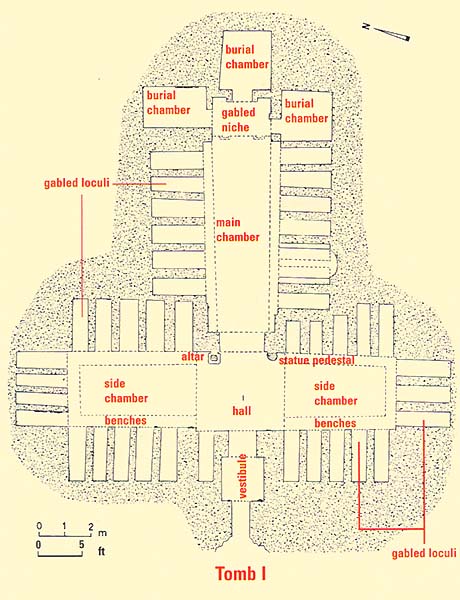
At the entrance to the largest burial chamber stood an altar and a base for a statue. Several loculi with gabled roofs are on each side of this chamber. In the rear of this main chamber, a large gabled niche leads to three small burial rooms.
The wall paintings are extraordinary. In the main chamber, beneath a continuous, undulating, suspended garland, is a frieze of animals, probably inspired by the famous royal zoo of the Ptolemies in Alexandria, which had engendered a widespread interest in the world’s fauna. Many of the animals in the frieze were represented in the Alexandria zoo.
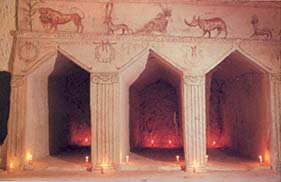
Labels identify the animals in the frieze, but the artist was clearly no zoologist. The animals are not drawn in proportion, their shapes sometimes so fantastic as to be barely recognizable, and the colors are wildly imaginary. A lion, for example, has the head of a man, perhaps inspired by the Assyrian lamasu, a mythological creature with a lion’s body, eagle’s wings and human face. A giraffe has a typical long neck, but a head far too large, and front and hind legs of equal length. One fish has tusks and a trunk like an elephant. Another fish has the head of a rhinoceros. Perhaps both fish reflect the theory of Greek sages that every terrestrial animal has a marine counterpart. In another scene a rhinoceros and a porcupine are the same size, suggesting that the artist was working from a book of illustrations and had never actually seen these animals. A representation of Cerberus, the mythological three-headed dog who guarded the entrance of Hades, was painted on a doorpost.
Perhaps the best-known scene is from Tomb II. (As drawn by the Dominican fathers, it appeared many years ago on the cover of BAR.)c A man in a short striped tunic with a flowery wreath on his head plays a double flute. He is followed by a woman in a long striped robe playing a lyre.
The tombs contain numerous inscriptions. Unfortunately, the immensely important inscription that allowed Peters and Thiersch to identify the site as Maresha has been cut out of the wall and robbed. The name of the deceased in this inscription is Apollophanes—a Greek. His great-nephew, buried in a nearby tomb, was Qosnatanos, a popular Idumean name. It preserves the name of the Edomite god Qos and means “Qos has given.” It is the Edomite equivalent of the Hebrew name Yehonatan (Jonathan in English), which means “Yahweh has given.”
Many of the inscriptions give dates. Those that are recorded according to the Seleucid reckoning correspond to dates between 196 and 119 B.C.E. Those recorded according to Ptolemaic reckoning are somewhat earlier.
The longest inscription, found in the main chamber of Tomb I, is not related to the tomb’s funerary function. Some say it is a dialogue between a man and a woman. Others say it is a message left by a married woman who regularly met her lover here; from now on, she says, they will have to communicate only by 067nods and sighs. Peters and Thiersch published this translation from the Greek:
There is nought that I may do [suffer] for thee or wherein I may please thee. I lie with another, though loving thee dearly. But, by Aphrodite, of one thing I am very glad: that thy cloak lieth in pawn. But I run away, and to thee I leave behind plenty of free room [complete freedom?]. Do what thou willst. Do not strike the wall; that does but make a noise; but through the doors. It lieth in nods. [By signs we communicate with one another. Let that be our agreement.]
Perhaps BAR readers will have a better interpretation than has been given by scholars in the century since the inscription was discovered. The Greek reads:
Ou[k e[cw tiv soi pavqw h[ tiv
carivswmai. katakei’mai meq ’e;tevrou
seJ mevga filou’sa. ’Alla; nai; th;n ’
Afrodivthn mevga ti caivrw, o{ti sou’
to; iJmavtion ejne;cura kei’tai. ’All ’
ejgw me;n ajpotrevcw, soi; de;
katalivpw eujrucwrivhn pollhvn.
prasse, o{ti bouvlh. Mh; krou’e to;n
toi’con, yovfo§ ejggeivnetai, ajlla;
dia; tw’n qnrw’n neuvmasi kei’tai
To prepare the site for visitors, Tombs I and II and their paintings have been reconstructed. First, an exact cast of each tomb was prepared by smearing a thin layer of rubber on the walls. The resulting extremely precise rubber mold was then used to create a full-scale tomb model made of concrecte and glass fibers. Pigment was added to match the color of the cave walls. Artist Hayim Kapchik then drew and painted the cave paintings on the molds. These were mounted on a frame structure that was affixed to the cave wall. Today the public can see the tombs almost as they looked 2,200 years ago, in all their ancient splendor.
Much of our work at the site of Maresha takes place underground—in tombs and in caves.1 BAR readers will not be surprised by the number of tombs, two of them with their walls covered with spectacular paintings. Much less common, however, are Maresha’s hundreds of caves. The subterranean labyrinth of spacious halls, small chambers, extensive winding corridors and industrial installations has led some to call Maresha an underground city. Maresha lies in the heart of the Shephelah, the rolling hills of Judah between the coastal plain and the mountains in central Canaan, about a thousand feet above sea […]
You have already read your free article for this month. Please join the BAS Library or become an All Access member of BAS to gain full access to this article and so much more.
Already a library member? Log in here.
Institution user? Log in with your IP address or Username
Footnotes
See Joseph Callaway, “Sir Flinders Petrie: Father of Palestinian Archaeology,” BAR 06:06.
Jerusalemites began to cut loculi in tombs in the second century B.C.E. At the end of the first century, the custom developed of placing the bones in a limestone box called an ossuary, instead of in a bone repository (as was used in First Temple days) or in a separate room.
Endnotes
From 1980 on, renewed research at Maresha was carried out intensively by the Israel Antiquities Authority (the IAA, then the Department of Antiquities of the Ministry of Education and Culture). From 1989 to 1994, six excavation seasons were conducted under the direction of the present writer on behalf of the IAA. The tomb restoration project, supervised by the IAA, began in 1993. As part of the park at the site, the excavation and restoration were funded by the Israel Government Tourist Corporation, the National Parks Authority and the Jewish National Fund together with the IAA. The site was opened to the public on Passover 1991.
Frederick J. Bliss and Robert Alexander Stewart Macalister, Excavations in Palestine 1898–1900 (London: Palestine Exploration Fund, 1902). Also see Michael Avi-Yonah and Amos Kloner, “Maresha (Marisa),” in The New Encyclopedia of Archaeological Excavations in the Holy Land, ed. Ephraim Stern (New York: Simon & Schuster, 1993), vol. 3, pp. 948–957.
Kloner and Nahum Sagiv, “The Olive Presses of Hellenistic Maresha, Israel,” in Oil and Wine Production in the Mediterranean Area, ed. Marie-Claire Amouretti and J.-P. Brun, Bulletin de Correspondance Hellenique, Supplement 26 (1993), pp. 119–136.
Kloner, “A Unique Hellenistic Juglet from Maresha (Marissa/Tell Sandahannah),” The Third Scientific Conference on Hellenistic Pottery 1991, ed. St. Drougou et al. (Athens, 1994), vol. 1, pp. 269–271, vol. 2, p. 218.
Eleazar D. Oren and U. Rappaport, “The Necropolis of Maresha-Beth Govrin,” Israel Exploration Journal 34 (1984), pp. 114–153.
John P. Peters and Hermann Thiersch, Painted Tombs in the Necropolis of Marissa (London: Palestine Exploration Fund, 1905).
